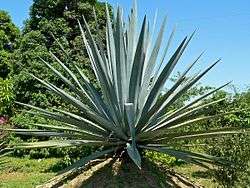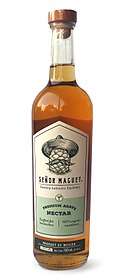Agave nectar


Agave nectar (more accurately called agave syrup) is a sweetener commercially produced from several species of agave, including Agave tequilana (blue agave) and Agave salmiana.[1][2] Agave syrup is sweeter than honey and tends to be less viscous. Most agave syrup comes from Mexico and South Africa.
Production
To produce agave syrup from the Agave americana and A. tequilana plants, the leaves are cut off the plant after it has been growing for seven to fourteen years. The juice is then extracted from the core of the agave, called the piña.[2] The juice is filtered, then heated to break the complex components (the polysaccharides) into simple sugars. The main polysaccharide is called inulin or fructosan and is mostly fructose. This filtered juice is then concentrated to a syrupy liquid, slightly thinner than honey. Its color varies from light- to dark-amber, depending on the degree of processing.
Agave salmiana is processed differently from Agave tequiliana. As the plant develops, it starts to grow a stalk called a quiote.[3] The stalk is cut off before it fully grows, creating a hole in the center of the plant that fills with a liquid called aguamiel. The liquid is collected daily. The liquid is then heated, breaking down its complex components into fructose and glucose and preventing it from fermenting into pulque.
An alternative method used to process the agave juice without heat is described in a United States patent for a process that uses enzymes derived from the mold Aspergillus niger to convert the inulin-rich extract into fructose.[4] Aspergillus niger, a fungus commonly used in industrial fermentations,[5] is "generally recognized as safe" (GRAS) by the U.S. Food and Drug Administration.[6]
Composition
Agave nectar consists of 56% fructose and 20% glucose.[7]
Culinary use
Agave syrup is 1.4 to 1.6 times sweeter than sugar[8] and is often substituted for sugar or honey in recipes. It is added to some breakfast cereals as a binding agent.[9]
Agave syrups are sold in light, amber, dark, and raw varieties. Light agave syrup has a mild, almost neutral flavor, and is therefore sometimes used in delicate-tasting dishes and beverages. Amber agave syrup has a medium-intensity caramel flavor and is therefore used in dishes and drinks with stronger flavors. Dark agave syrup has stronger caramel notes and imparts a distinct flavor to dishes, such as some desserts, poultry, meat, and seafood dishes. Both amber and dark agave syrups are sometimes used "straight out of the bottle" as a topping for pancakes, waffles, and French toast. The dark version is unfiltered and therefore contains a higher concentration of the agave plant's minerals.[10]
Calories and glycemic index
Agave nectar has a high sweetness factor because it is composed of 70% to 90% fructose, giving an impact on blood sugar comparable to pure fructose, as measured by its glycemic index.[11] Although supplying more calories (60) compared to the same amount of table sugar (48), agave nectar has greater sweetness, indicating that its use per volume can be relatively lower, and it is not favorable as a low-calorie sweetener.[11]
See also
References
- ↑ Hocman, Karen (August 2009). "Agave Nectar a.k.a. Agave Syrup". The Nibble.
- 1 2 Gary M. Mohr, Jr. (3 October 1999). "Blue Agave and Its Importance in the Tequila Industry". Ethnobotanical Leaflets. Retrieved 4 January 2010.
- ↑ "Monocarpic Behavior in Agaves". J. C. Raulston Arboretum, North Carolina State University. June 19, 2009. Retrieved 2010-01-04.
- ↑ "Method of producing fructose syrup from agave plants (United States Patent 5846333)". 1998-12-08. Archived from the original on 2007-09-26.
- ↑ Onions, A.H.S., Allsopp D., Eggins H.O.W. (1991). Smith's Introduction to industrial mycology. (7th ed.). Cambridge, UK: Cambridge University Press. ISBN 9780521427821.
- ↑ "Inventory of GRAS Notices: Summary of all GRAS Notices". US FDA/CFSAN. 2008-10-22. Archived from the original on 11 October 2008. Retrieved 2008-10-31.
- ↑ Ralf Patzold; Hans Bruckner (2005). "Mass Spectrometric Detection and Formation of D-Amino Acids in Processed Plant Saps, Syrups, and Fruit Juice Concentrates". J Agric Food Chem. 53 (25): 9722–9729. doi:10.1021/jf051433u.
- ↑ Johannes, Laura (October 27, 2009). "Looking at Health Claims of Agave Nectar". The Wall Street Journal. Archived from the original on 2 January 2010. Retrieved 2010-01-04.
- ↑ Chomka, Stefan (30 July 2007). "Dorset Cereals". The Grocer. Crawley, England: William Reed Business Media. Retrieved 16 January 2011.
- ↑ Getty, Anna (2010). Anna Getty's Easy Green Organic. Dan Goldberg and Ron Hamad, photographs. San Francisco: Chronicle Books. p. 141. ISBN 0-8118-6668-8. Retrieved 25 November 2011.
- 1 2 Hamblin, James (5 June 2014). "Being Happy With Sugar". The Atlantic. Retrieved 12 March 2017.
